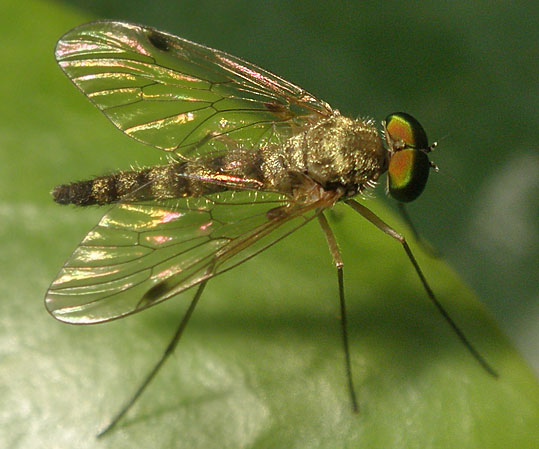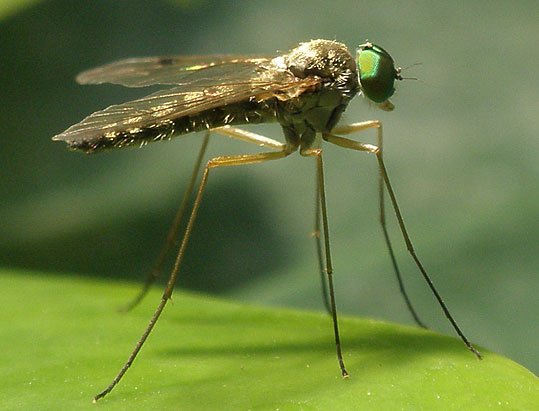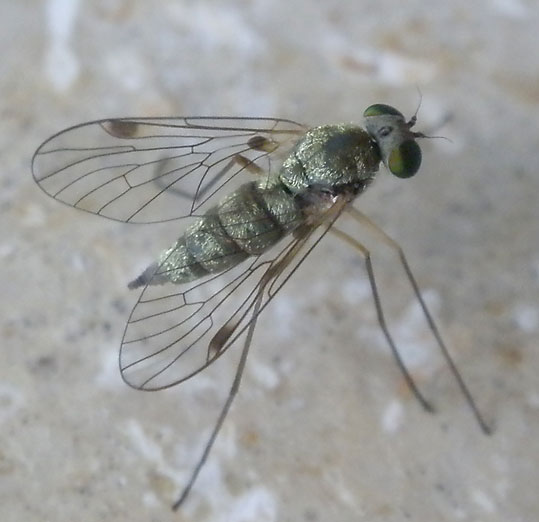|
Chrysopilus asiliformis
Little Snipefly
Kleine Schnepfenfliege
|
|

Male specimen. Specimen photographed in
Frankfurt am Main (Hessen) on June 2, 2011.

Male specimen.
Specimen photographed in Frankfurt am Main
(Hessen) on June 2, 2011.

Female specimen. Specimen photographed in
Göttingen (Niedersachsen) on July 7,
2012.
Subspecies
Krivosheina
(2006) considers two subspecies of C.
asiliformis (but note that she uses the name
Chrysopilus aureus): Chrysopilus aureus aureus
and Chrysopilus aureus meridionalis. However, the
diagnostic differences given by Krivosheina
are not convincing. The figures of the genitalia
of meridionalis and aureus are virtually
identical, and contrary to the diagnosis by
Krivosheina I can see no significant differences
in the shape of sternite IX: both are wedge
shaped, with a posterior notch and an
anterior slightly concave edge. The
pterostigma of this species is dark, but the
sides are blurred, thus the length of the
pterostigma can vary in different specimens.
Krivosheina (2006) proposes that those with
a short pterostigma are aureus and those
with a longer pterostigma (exceeding the
base of M4) are meridionalis, but I have
seen copulae where one sex had the long and
the other sex the short pterostigma.
Finally, the color of the coxae is said to
differ, but this is variable as well and I
cannot currently correlate this variability
with two distinct subspecies. Thus, I do not
recognize subspecies of Chrysopilus
asiliformis.
Original description
Preyssler,
1791
Synonyms
Rhagio diadema
Fabricius, 1775 (nec Musca diadema Linnaeus,
1767) (misidentifaction)
Leptis
diadema (Fabricius, 1775)
Atherix
diadema (Fabricius, 1775)
Musca diadema
(Fabricius, 1775)
Chrysopilus diadema (Fabricius, 1775)
Musca
asiliformis Preyssler, 1791
Chrysopilus asiliformis (Preyssler, 1791)
Rhagio aureus Meigen,
1804 (p. 302)
Atherix aureus (Meigen, 1804)
Chrysopilus aureus (Meigen, 1804)
Chrysopilus aureus aureus (Meigen, 1804)
Atherix aurulans Meigen, 1820 (p. 101) (nomen
nudum, based on in litteris name)
Rhagio aurulans (Meigen, 1820) (nomen nudum)
Atherix lurida Meigen, 1820 (p. 101) (nomen nudum,
based on in litteris name)
Atherix luridus Meigen, 1820 (nomen nudum)
Rhagio luridus (Meigen, 1820) (nomen nudum)
Atherix vitripennis Meigen, 1820 (p. 101) (nomen nudum, based on
in litteris name) (nec Leptis
vitripennis Meigen, 1820 (p. 91))
Leptis vitripennis (Meigen, 1820) (nomen nudum) (nec Leptis
vitripennis Meigen, 1820 (p. 91))
Chrysopilus
meridionalis Bezzi, 1898
Chrysopilus
aureus
meridionalis (Bezzi, 1898)
Fabricius
described Rhagio diadema and suggested in
the original description that it was
identical to Musca diadema described by
Linnaeus. However, Musca diadema Linnaeus,
1767 is not a Rhagionidae species. This was
thus an misidentification by Fabricius.
Moreover, when Gmelin transferred
Fabricius´ Rhagio diadema to the genus
Musca, both names became homonyms.
The original description by Preyssler (1791)
is very detailed for its time and there is
also a good image clearly showing a female
Chrysopilus species. The description is
sufficient to identify this species even
though no types are known to exist. The size
given by Preyssler, 2.5 Parisian lines (about
5,75 mm) additionally confirms the identity,
because most other Central European species
are larger.
Atherix
aurulans, Atherix luridus and Atherix
vitripennis have been listed as synonyms in
the Fauna Europaea Web Service (2004).
However, the text of Meigen (1820, p. 101)
only states that specimens of Leptis diadema
have been sent to him by other researchers
under these names. Thus, these names are
names in letters and were not intended as
name descriptions. In addition, the Atherix
vitripennis mentioned by Meigen in the
description of Rhagio diadema on page 101 is
not the same as the Leptis vitripennis
described by him on page 91. This is an
error in the Fauna Europaea Web Service
(2004).
Identification
Distribution
Biology
This page has been updated on October 27, 2011
This site is online since May 31, 2005
Copyright © by Nikola-Michael Prpic. All
rights reserved.
|
|
|



